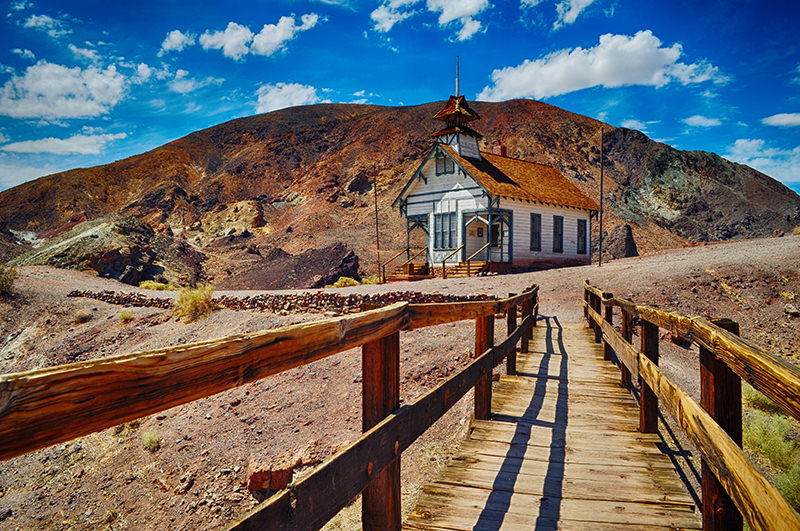10 Mojave Desert Ghost Towns
1. Calico Ghost Town
Founded in 1881 as silver mining town, Calico Ghost Town is now an attraction. In the 1890's when the silver boom declined and borax was discovered, the population soared to 3,500 and became a thriving desert community. This would end by the turn of the century and by 1907 became a true ghost town.
2. Cima
Cima is a ghost town located in the Mojave National Preserve. Founded in 1900 with the opening of a store and later post office in 1905, H.C. Gibson made the town famous because he did not pump gas for his customers making this the original self-service station. The Union Pacific Railroad passes the lazy town each day on its historic route.
3. Ivanpah
Ivanpah, Native American for 'clear water', was a silver ore mining town established in 1869. At its peak, the town included a hotel, two stores and post office. By the 1880's, better mines were discovered in nearby settlements so residents abandoned Ivanpah in search of bigger riches.
4. Kelso
Kelso was an important railroad service stop for the Los Angeles & Salt Lake Railroad and was crucial during World War II for the war effort delivering key goods via Union Pacific. The National Park Service saved the iconic train depot from demolition when abandoned after passenger service ended in 1964 and restored it to its original glory.
5. Amboy
Amboy is an historic Route 66 Ghost Town on the outskirts of the Mojave National Preserve. It became a boom town in 1926 after the completion of Route 66. In 1938 'Roy's Motel and Café' opened to serve tourists traveling the famed Mother Road. It's iconic Mid-Century modern neon sign was added in 1959. Interstate 40 opened in 1972 and put the town completely out of business.
6. Zzyzx
Zzyzx is the former site of Zzyzx Mineral Springs & Health Spa in the Mojave National Preserve. Curtis Howe Springer founded the spa in 1944 naming it Zzyzx so that it would become the very last word in the dictionary. He claimed his hot springs could heal all health problems. The springs were actually just faked by warming the water with a boiler and adding herbs! The government caught up with Springer in the 60's and the Resort was shut down. California State University built a Desert Studies Center here in the 70's while all that remains of the resort are ghostly ruins. A car graveyard is the highlight of the ruins.
7. Randsburg
Gold was discovered in 1895 at the Rand Mine and a camp was soon formed in this remote Mojave Desert enclave. Located near the other boom town of Johannesburg, the two names merged to spell Randsburg. With a population today of about 70, it is a true western ghost town. The famous General Store as well as its charming abandoned sites and sounds make it a must stop along the beautiful Highway 395.
8. Ballarat
At the edge of the Panamint Mountains on the western outskirts of Death Valley lies Ballarat, an historic mining camp that lasted from 1897 to 1917. The town had several hundred residents at its peak with seven saloons, three hotels, a Wells Fargo station, post office, school and infamously no church.
9. Keeler
Keeler is a ghost town outside of Death Valley National Park in the Eastern Sierra Nevada known as the 'End of the Line'. The Carson and Colorado Railway extended their railroad all the way here during the Gold Rush in 1883. When nearby mining towns went bust, plans to extend the railway further to Mojave fell through and Keeler became the last stop of the line.
10. Harrisburg
Harrisburg contains the ghostly remains of Peter Aguereberry's famous Death Valley mining camp. He first discovered gold here with his partner Shorty Harris in 1905. Pete would remain here for forty years until 1945. His camp and mining ruins patiently stand against the test of time.










